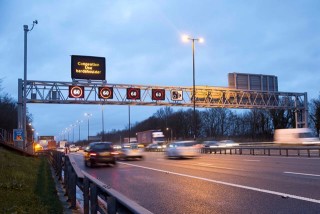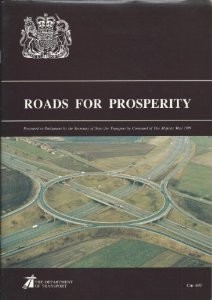Contractors are being told to gear up for a massive investment in the UK’s road network. Once the Cinderella of infrastructure, can roads now compete for funding with the same success as the rail network?
In summer 2013 transport secretary Patrick McLoughlin announced what he called ‘a transformational investment in our road network’ with £12bn for road maintenance and a trebling of investment in major road schemes, including the addition of over 400 extra lane-miles of capacity, resurfacing 80% of the strategic road network and upgrading our most important ‘A’ roads. And in February 2014, at the Highways Supply Chain Summit, roads minister Robert Goodwill called on Britain’s road building companies to get ready for a massive increase in work ahead of the biggest investment in the road network since the 1970s, saying that the government is tripling funding on roads over the next eight years.
But the industry has seen the road building and maintenance budget shrink massively over the past few years. And it has also seen promised road-building programmes dwindle to nothing – most dramatically with the ill-fated Roads for Prosperity programme (see panel opposite). As recently as 2011 the Autumn Statement contained £5.5bn of capital investment and £10bn of private investment for infrastructure and only 10% of that investment was actually realised, according to Noble Francis, economics director of the Construction Products Association.
But this time, he says, it is different and this programme of investment is not just a pre-election boost to the economy. “This is far too long-term to be political and the government is trying to be as clear as it can about what it is trying to achieve,” he argues. “What is good about this initiative is that government has worked with the industry to find out what it needs to be confident that this investment will take place – precisely because of the number of times that governments have made ambitious announcements and nothing has happened on the ground.” But it is not just the consultation and clarity that has impressed the industry. In a year’s time the Highways Agency will become a publicly owned company operating on similar lines to Network Rail – and that is seen as being the touchstone of the government’s integrity in delivering the promised funding.
Under the proposals published in July 2013, the Department for Transport will assume total control of policy with the Agency being charged with implementing it. The theory behind the move is that turning the Agency into a company will enable it to be “more nimble” than it has been in the past, allowing it to compete for the best talent in the job market.
As a publicly-owned company, the new body will be given six-year funding certainty for capital projects and maintenance. A major commitment from the Government is that both the funding and reform will be reinforced by legislation so that no future government can back away from these commitments.
This, it says, should provide the construction and maintenance industry all the reassurance needed to recruit and train skilled workers to deliver an increase in transport projects. The Government is also expecting to make savings, estimating that the reforms could save £600m. Introducing the changes to the way in which road building and maintenance is commissioned, the government said that it would establish a legal framework to guarantee investment through a roads investment strategy. It pointed to the success of Network Rail in owning, operating and maintaining the railway infrastructure.
The industry welcomed the initiative with a chorus of relief and approval. Francis spoke for many, saying: “A lot of investment has been stop-start with no clarity in the medium term.” His organisation, the Construction Products Association, is also part of the Infrastructure Alliance together with the Institution of Civil Engineers (ICE), the Association for Consultancy & Engineering (ACE), and the Civil Engineering Contractors Association (CECA). He points out that members of the CPA cannot plan to supply the materials required for road construction without some confidence in the government’s long-term plans. “Most of the major companies are global multinationals so the investment decisions are made at global level and far in advance,” he commented.
But that certainty in the longer term depends on the government delivering on its promise to reform the Highways Agency, points out CECA chief executive Alasdair Reisner.
“If the bill to change the status of the Highways Agency goes through then we can have great confidence in the five year funding settlement which will enable the industry to plan for the long term,” he says. Reisner looks forward to roads becoming like the rail sector, where the regulator could theoretically step in to demand changes to the programme of investment but, in practical and political terms, it is very unlikely.
Early press reaction to the reform focused on the potential for the staff of the new body to be rewarded through bonuses for exceptional performance, although such payments would be subject to independent monitoring of the new company’s performance. Possible safeguards could include setting up a drivers’ champion to operate on similar lines to Passenger Focus, which acts as a consumer watchdog for the rail and bus industry, or the establishment of an economic regulator, similar to OFWAT, to scrutinise performance.
At the same time, though, the government announced that it wanted to tackle some of the most notorious and long-standing road hot spots in the country – and that the Highways Agency, initially through feasibility studies, was to look at problems and identify potential schemes.
The locations identified are:
- A303/A30/A358 corridor
- A1 north of Newcastle
- A1 Newcastle-Gateshead Western Bypass
- A27 corridor (including Arundel and Worthing)
- Trans-Pennine routes
- A47 corridor between Peterborough and Great Yarmouth
Industry reaction to this is ambivalent. On the one hand it is seen as further evidence of the government’s commitment to investment in the country’s infrastructure. “They can’t detail all their spending plans as that would be too difficult but they are giving some indication of their long-term plans,” comments Francis.
But others worry that the Highways Agency is actually in danger of being overburdened. “The agency is facing a challenge in dealing with an upturn in activity compared to the last few years while also preparing feasibility studies for schemes in the long term and also preparing for a changing role,” notes Andrew Hugill, director of policy and technical affairs for the Chartered Institute of Highways and Transportation (CIHT).
Or as David Weeks, director of the Asphalt Industry Alliance, puts it: “I fear that if they [the Highways Agency] are worried about the structure and the organisation itself they will take their eye off the ball and the existing motorway network might suffer.”
The earliest signs, though, are that the Highways Agency is both capable and committed in adhering to the schedule. Just last month it issued its shortlist of contractors for its new-style collaborative delivery framework. It invited tenders from shortlisted bidders in March that should be returned by late May. The HA is aiming to use the new framework for between £4bn-and £5bn-worth of schemes over the next four to six years.
The framework is intended to establish closer working ties with designers and Agency officials while boosting the capability of small and medium sized contractors by increasing the upper threshold on the two lower value construction lots over the life of the project. This, the Agency says, will enable suppliers to bid for bigger jobs as their skills and capabilities develop, allowing them to compete with established major contractors.
.png)
Highways Agency procurement and commercial director David Poole said: “The collaborative delivery framework is emblematic of the way the Highways Agency wants to do business – working collaboratively to innovate and deliver more for less while building capability across the whole industry. It is also proof of the Agency gearing up for the biggest increase in roads investment since the 1970s. I’ve been hugely encouraged by the engagement we have seen in the process so far, and this is reflected in the number and variety of the suppliers shortlisted.”
The schemes involved include projects such as the A14 Cambridge to Huntingdon, together with managed motorways, motorway widening, junctions, bypass schemes, asset renewal works and pinch points. The framework award is expected to be made in the autumn, which will be another important step to reassuring the industry that the promised schemes will actually occur.
But the most important event is for the legislation that will transform the Highways Agency to be passed in this parliament, as Reisner points out.
“If this legislation doesn’t happen in this parliament then it will destroy any certainty that civil engineering industry might have had in the roads programme. While we believe that this is the right way to proceed and that there is broad, cross-party support, a new government would have its own priorities” he concludes.
Projects in the pipeline
The 2013 spending round confirmed 26 major road schemes to start in this parliament and committed funding to start a further 26 schemes in the next parliament, subject to value-for-money and deliverability.
Schemes underway:
- M62 Junctions 25-30. Spending Round 2010 scheme now open to traffic
- A23 Handcross–Warninglid
- M4 Junctions 19-20 and M5 Junctions 15-17. SR10 scheme now open to traffic
- M6 Junctions 5-8
- A11 Fiveways-Thetford
- A453 Widening (M1 junction 24 to A52 Nottingham)
- M25 Junctions 23-27
- M25 Junctions 5-6/7
- M6 Junctions 10a-13
- M1 Junctions 39-42
- A14 Kettering Bypass
- M1/M6 Junction 19 Improvement
- A45/A46 Tollbar End
Schemes to start before 2015:
- M1 Junctions 28-31
- M1 Junctions 32-35a
- M3 Junctions 2-4a
- A1 Leeming to Barton
- M60 Junctions 8-12
- M60 Junctions 12-15
- M62 Junctions 18-20
- A1 Lobley Hill [NB. Dec 2013 investment announcement confirmed the length of this scheme would be extended.]
- A556 Knutsford-Bowdon
- A5-M1 Link Road
- M25 Junction 30/A13
- A30 Temple to Carblake
- A160/A180 Immingham
Who gets the work: the collaborative delivery framework shortlist
Lot 1 is for professional design and engineering services:
- AecomECOM
- Amey OW
- Arup
- Atkins
- Capita Symonds – Design & Infrastructure / Ramboll UK JV
- CH2M Hill
- Hyder Consulting (UK)
- Jacobs Engineering UK
- Mott MacDonald / Grontmij JV
- Mouchel
- Pell Frischmann Consulting Engineers
- Royal HaskoningDHV
- RPS Group
- URS Infrastructure & Environment (UK)
- Waterman Transport & Development / Tony Gee & Partners/ WYG Engineering JV (part of W2G Highways consortium)
- WSP Civils / Parsons Brinkerhoff JV
Lot 2 is for medium-value construction works with scheme values of up to £25m that might be increased up to £50m:
- EM Highway Services
- VolkerFitzpatrick
- McLaughlin & Harvey
- John Graham Construction
- Interserve Construction
- Amey LG
- Alun Griffiths (Contractors)
- Geoffrey Osborne
- Galliford Try Infrastructure
Lot 3a is for high-value construction works with scheme values from £25m up to an initial value of £100m which may be increased up to £300m:
- Galliford Try Infrastructure
- BAM Nuttall / Morgan Sindall JV
- Hochtief (UK) Construction
- John Sisk & Son / Lagan Construction JV
- Kier Construction
- Vinci Construction UK (trading as Taylor Woodrow)/Vinci Construction Grands Projets JV
- Laing O’Rourke Construction
- Amey LG
- Carillion Construction
- Costain
- Skanska Construction UK
Lot 3b is for high-value construction works with scheme values of between £100m and £450m.
- Balfour Beatty Civil Engineering
- BAM Nuttall / Morgan Sindall JV
- Bouygues TP
- Carillion Construction
- Costain
- Skanska Construction UK
- Laing O’Rourke Construction
Roads for prosperity
Scepticism over the delivery of any large road-building programme is founded on the industry’s experience of the 1989 White Paper, Roads for Prosperity, which announced a greatly expanded motorway and trunk road programme to relieve congestion on major roads between towns and cities.
It emphasised reducing inter-urban congestion and prioritised meeting the needs of industry and of other road users for a modern strategic road network.
The new roads were met with huge opposition and there were mass protests against individual schemes – a point that bruised many of the politicians involved. The Tory transport minister in 1992, Steven Norris, commented: “I …saw first-hand the difficulty in implementing the Roads for Prosperity programme. Such was the opposition and cost, three-quarters of the plans never got off the drawing board… Experience tells us that a massive programme of road building won’t solve these problems [of economic inertia, congested roads and housing shortages].”
Within five years the road-building programme was hacked back wholesale:
- 11 schemes were reviewed for smaller-scale improvements;
- eight transferred to the network enhancement programme;
- 104 were placed in the longer-term programme; and
- 77 schemes were withdrawn (including most of the 67 schemes placed in the ‘longer-term’ programme in 1994).
This was the last ever example of the transport planning orthodoxy that had dominated planning from the late 1950s onwards, the so-called ‘predict and provide’ model in which future traffic was forecast and then the road space built to accommodate it.
A Standard Note lodged in the House of Commons Library entitled Roads: highway infrastructure drily comments: “Quite apart from the environmental objections, funding from the public purse is strictly limited and it would be impossible to build roads to cope with the projected increase in the volume of cars forecast.”
This article first appeared in the April 2014 issue of The Construction Index magazine, which can be viewed in full at: http://epublishing.theconstructionindex.co.uk/magazine/april2014
While the magazine is free to view online, a subscription is required to receive you own hard copy every month. This can be purchased for just £35 a year at http://www.theconstructionindex.co.uk/magazine
Got a story? Email news@theconstructionindex.co.uk







